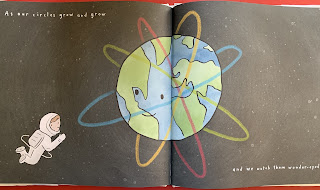
Here
are 2 books with similar themes. Strong Suggestion:
Don’t dismiss these books because there are only females in them. Your boys
need to hear and will learn from books featuring only girls. Females have done this throughout literary history! Encourage your boys to use their inner voices to "translate" when necessary. Most experiences in these books will be applicable to all genders!
There is a teachable moment here regarding the Jesus’ version of The Great Commandment which added strength to the ideas of loving God and neighbor. Tap into your boys' desire to have strong-loving minds and hearts so they will develop empathy for girls & women. That will benefit everyone!
The 1st book is a particularly beautiful collection of diverse girls declaring female power. These declarations can be extrapolated to boys easily.
The
2nd book is silly and fun, but it’s rich with meaning. It's a story about
choosing to be yourself, rather than pretending. Engage boys by asking how they like to dress and play in costume. There is a lot of potential
here for children, teens, and adults, particularly with recent political issues regarding gender.
Also, check out the PBT books I link to below that are similar in theme or content!
Picture Book: I Am Enough
Author: Grace
Byers
Illustrator: Keturah A Bobo
Summary: This
book is not a narrative. Instead it is a book of similes that describe what is LIKE
us – (these beautiful young girls and all of us!). It begins, “Like the sun,
I’m here to shine.” Here’s a favorite: “Like the rain, I’m here to pour
and drip and fall until I’m full.” This simile deserves some group interpretation! Only girls are shown. Talk about that. Then note that their
situations are not “girly” – whatever that means.
Hanna’s Comments: These declarations emphasize loving who you are, but they also
emphasize being kind and respectful to who other people are! Have your
audience note how the girls are interacting. Then talk about what Godly attributes
they see or ask what Jesus would think of their words and actions. Explore ideas of The Holy Spirit giving them strength and resilience. There is a lot of movement in these pages so you might read again with group gestures or a simple dance.

Original Publisher: Balzer & Bray, 2018
Age Appropriateness: 3 and up
Formats other than Book: Tablet & Audio
Picture Book: I’m Me!
Author: Sara
Sheridan
Illustrator: Margaret Chamberlain
Summary: Little Imogene loves to play dress-up with her Auntie Sara! When she is greeted, it is clear that her auntie is ready to play. She keeps asking Imogen which world they will enter today. The double-page spreads become some of these imagined worlds and play-possibilities. Imogen keeps saying, "No. Today I want to be..." but then her auntie interrupts with another imaginary possibility. Finally, Imogen says that she wants to be... ME! The two playmates go have a grand and wonder - ful time at the park!
Hanna’s Comments: Practice reading this book for full impact. You want the drama of Imogen's words and your page-turning to have good effects. Ask your children about how feelings influence whether they want to pretend or be themselves in the real world. Be sure to remind them that God is always present in their imagined worlds and their real world. You might even want to talk about how God has given us humans particularly skillful imaginations for solving problems (think scientists & explorers) and for having fun (think writers & entertainers). If time allows, talk about how the practice of wonder leads people to think about God, God's world, and how we fit in to its beauty and joy.
Original Publisher: Chicken House, 2011
Age Appropriateness: 4 and up
Formats other than Book: None at present
For both books...
Scripture Connections: God created humankind in God's image (Genesis 1:27); I praise You, for I am fearfully
and wonderfully made. Wonderful are your works. (Psalm 139: 14); ...the joy of the Lord is your strength. (Nehemiah 8:10); We have different gifts, according to the grace given to each of us. (Romans 12:6); My flesh and my heart may fail, but God is the strength of my heart. (Psalm 73:26); And other verses about strength in God and personal gifts from God.
Connections to The Revised Common Lectionary: Both books are listed in
my Trinity Treasures preschool curriculum for Year B in a lesson featuring
Psalm 139.
PBT Applications: Read 1 or both of these books in an elementary Sunday
school class. Talk about how Psalm 139 can be such a comfort when we are feeling unworthy and self-doubt
creeps in OR when we are feeling lonely and we forget God is always with us.
Links to similar PBT books:
Psalms for Young Children
When God Made Light
From Head to Toe God Made Me
Stand Tall Molly Lou Melon
Have Fun Molly Lou Melon
Emma Dodd books see When I Grow Up or Just Like You
When I Hold You
Baby Believer series see Psalms of Praise: A Movement Primer
All of Me: A Book of Thanks
If you are interested in learning more about my Trinity Treasures, a
scripture based preschool Sunday school curriculum that features picture books
& children’s Bibles, contact me at hannaschock@bellsouth.net. Right
now, free lessons are emailed if you agree to fill out the monthly feedback
form.



























